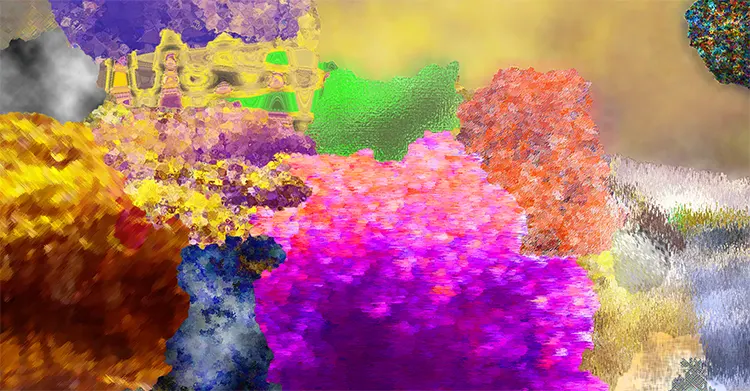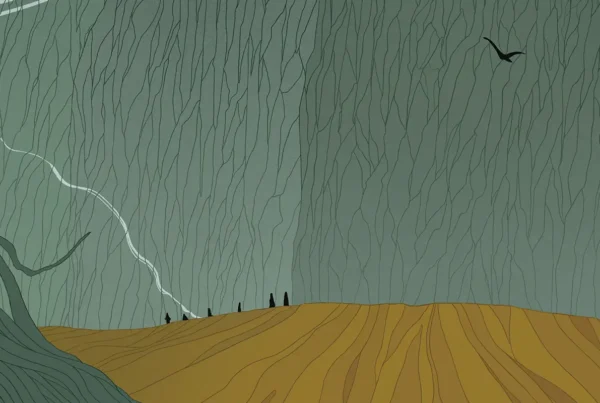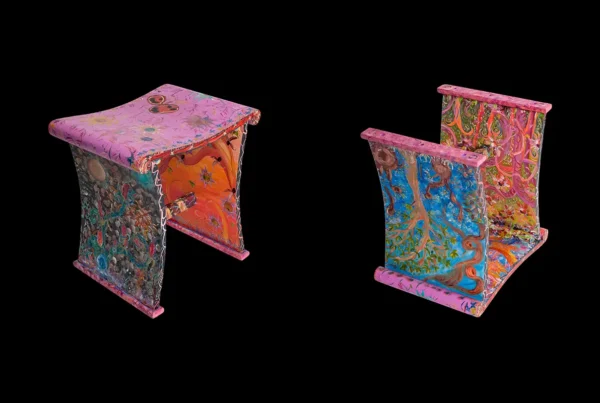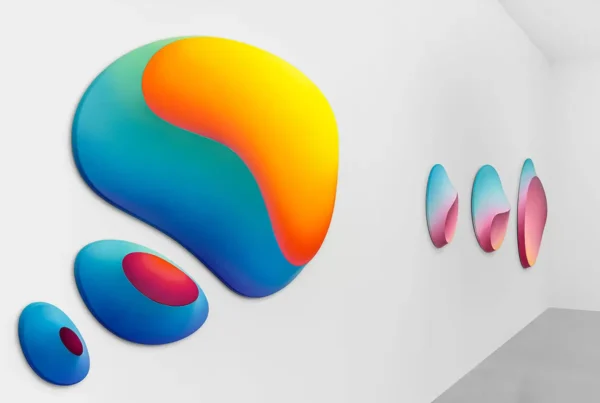“My small goal is to bring the art world back to ‘beauty’.”
Art as a Labor of Love
Art has captivated PCOOL from an early age. Despite his academic proficiency, his socio-economic circumstances constrained him from pursuing formal education in art or related fields. Originating from Thailand, a country grappling with social disparities, he belongs to the lower-middle class. His parents endeavored to provide him with the best education possible at the renowned institution established by French missionaries, ‘Assumption.’ The financial uncertainties and scant career opportunities in the arts sector in Thailand dissuaded him from seeking admission to an art university.
In this context, art in Thailand is not merely a professional endeavor but a labor of love, requiring both exceptional talent and fervor. PCOOL, as a result, charted an unconventional path, intertwining political and cultural activism with philosophical studies. The culmination of these experiences led to a profound philosophical liberation, enabling him to relinquish societal burdens.
This newfound freedom propelled PCOOL towards the domain he yearned for, as he spearheaded the fusion of food and art by founding the premier art restaurant with gallery ‘Hemlock’ in Thailand in 1994. His artistic and innovative vision garnered the attention of academia, leading to an invitation to teach ‘Aesthetics’ at the prestigious ‘Bangkok University’ within three years.
PCOOL’s pedagogical journey expanded as he also began teaching at the state’s leading art institution, ‘Silpakorn University’. His academic engagements spanned over 14 years, where he nurtured minds at both undergraduate and master’s levels. Concurrently, he was conceptualizing and executing his personal art projects.
In the end, he chose to retire from his teaching career to devote himself entirely to the world of art. Since around 2014, PCOOL has been an established artist, venturing into the experimental domain and amassing a comprehensive collection of his creations.

Navigating the Paradoxes of Art in the Postmodern Era
Beyond the pursuit of social equality, the pinnacle of human civilization manifests within the realm of art, a thought-provoking domain teeming with paradoxes. Within this canvas of human experience, the tension between hope and despair comes alive as humanity navigates from the Modern into the Postmodern era. PCOOL views technology as a double-edged sword, embodying hope and opportunities, while simultaneously presenting threats and existential risks, demonstrated by wars that have recurrently pushed mankind to the brink of annihilation.
In the face of such tumultuous times, human comprehension of the universe has exponentially expanded, with digital technology amplifying this knowledge growth at light speed. Yet, paradoxically, our understanding of ourselves remains tragically limited. PCOOL reveres the Impressionist artists who, despite the encroachment of camera technology, remained steadfast in their love for the craft, skirting the commercialization of art. They sought a connection to humanity through the lens of beauty rather than mere novelty or peculiarity, all while pioneering revolutionary approaches to their craft.
PCOOL often contemplates the hypothetical artistic expressions of maestros such as Monet, Van Gogh, and Picasso if they were transported to our contemporary digital era. The answer, in his estimation, unequivocally involves their engagement with digital mediums.
Parallel to the advancement of digital technology, specifically within photography and digital art, PCOOL has progressively refined his craft, interlacing the techniques of old masters with digital finesse. His artistic journey has been characterized by a period of silent productivity during which he methodically honed his craft, creating an array of works without seeking public display, even within his own gallery.
It was amidst the melancholy of the COVID-19 pandemic that PCOOL decided to publicly showcase his work for the first time. He submitted a digital fine art piece— a segment largely dominated by cartoons and characters rather than serious fine art— to a competition. This piece, entitled “Neo Klimt #1,” was an abstract homage to Klimt. The work was immediately chosen for the London Art Biennale 2021, marking the inception of PCOOL’s public artistic journey.
This milestone coincided with the artist’s decision to share his work, spanning both digital art and photography, within a limited circle, such as his personal Facebook page. This choice stemmed partly from a sense of estrangement from the traditional art world and market, and partly from his apprehension surrounding the dubious nature of the burgeoning NFT market.

Unleashing the Potential of Digital Art
Engaging with two diverse mediums, 2D Digital Art and Photography, the artist PCOOL has displayed an affinity for exploring the dichotomy between modern technology and traditional craftsmanship. This discussion will primarily focus on his forays into Digital Art. PCOOL invokes the ethos of the bygone artistic masters, yet he boldly ventures into the digital domain, maximizing the potential of modern computing.
PCOOL seeks to discover a distinctive beauty, one that can be uniquely harnessed by technology, yet remains challenging for human hands alone. His work may appear peculiar to some, but his primary pursuit remains an exploration of aesthetic charm. It is, however, paramount to him that he contributes to the progression and evolution of human civilization, rather than simply furthering an AI-driven world. He longs to maintain a world of explicit beauty, a phenomenon he dubs ‘the direct touch’, avoiding mere eccentricity for its own sake.
Living in an era teeming with innovative yet outlandish artistic interpretations, PCOOL often finds himself reflecting upon the life of Van Gogh. Much like the solitary master, who lugged his painting supplies into open fields without companionship, PCOOL too finds solace in his solitude with just his computer notebook and a humble compact camera. Despite the pioneering nature of his work, his productivity is tempered by his conviction to remain faithful to his distinct vision, to craft work that transcends ephemeral novelty and instant gratification, work that communicates on a more profound level.
As such, his work may occasionally appear marginalized, caught in the tension between innovation and tradition. Yet, this very marginality could reveal itself as the nucleus, the ‘yolk circle’, upon closer scrutiny. It may be minuscule, or perhaps, like many artists before him, he may not live to witness its true impact. PCOOL remains mentally prepared for such a scenario, and his time in the art world, every moment, offers him satisfaction in his self-contained universe.

Finding Balance: The Beauty of PCOOL’s Artistic Journey
PCOOL demonstrates a profound respect for eminent artists such as Van Gogh, Monet, and Picasso, yet he does not strive to imitate their styles. He acknowledges a host of influences that he has greatly admired and absorbed from, without ever feeling beholden to a particular artistic hero. His work is a mélange of styles and influences, sometimes antiquated, occasionally imbued with an element of kitsch, and at other times, characterized by an abstract or surrealistic approach. His work could be likened to a child’s drawing or a piece of ornamental design, or it might be described as a fusion of diverse elements juxtaposed into one composite artwork.
The rawness of Impressionism and Post-Impressionism, when contrasted with Realism, can be seen reflected in his own pieces, which often exhibit a degree of abstraction and roughness that exceeds even that of Monet and Van Gogh. He emphasizes the significance of scale and proximity to the viewer in perceiving his art, suggesting that different levels of ‘zoom’ offer distinct, rewarding experiences. The viewer’s general perception might categorize most of his works as simultaneously dynamic yet serene. Despite the apparent spontaneity, each piece involves a certain degree of premeditation, coupled with a large measure of improvisation.
Currently, PCOOL is intent on reintroducing the concept of ‘beauty’ to the art world, in lieu of mere stylistic eccentricity. This ‘beauty’ he refers to encompasses both the external and internal facets of humanity, an attribute that warrants both humility and pride. His growing fascination with Artificial Intelligence has instigated a desire to encourage his contemporaries to reflect on the equilibrium between rapid technological progression and organic life. This concept has gradually manifested in his work. Whether his creations are of a simplistic or intricate nature, the overarching theme poised to dominate his future work is ‘balance’, referring to this harmonious coexistence of technology and the organic.
You can reach PCOOL directly, by email, at [email protected]






